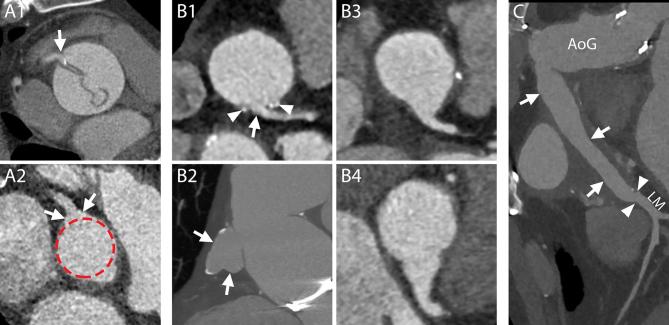Figure 6.
Normal aspect of coronary artery sutures and origin. A1–A2, The most commonly practiced version of the Bentall procedure includes preservation of a “button” of native aortic wall around the coronary ostia that will be sutured to the aortic graft. Therefore, most commonly, even coronaries that before the operation had an abrupt origin from the aortic wall (A1, arrow) after the operation will show an enlarged emergence (A2, arrows) protruding from the circular profile of the graft (A2, dashed line) due to the additional tissue of the button of the native aorta. A1–A2, MPR perpendicular to the centerline of the aorta. B1–B4, B1 and B2, Depending on the extension of the resected native aortic wall, the appearance of the new origin of the coronary artery can be very different, as shown in these two case examples: almost normal (B1, arrow at the origin of the left coronary artery) or very enlarged (B2, arrows at the origin of the right coronary artery). Surgical material can be seen at the level of the suture lines (B1, arrow heads). B3 and B4, The shape of the origin can be different as well, and can have a “trumpet-like” (B3) or “flask-like” (B4) appearance. B1, B3, B4, MPR perpendicular to the centerline of the aorta. B2, MPR parallel to the centerline of the aorta. C, A graft (arrows) can be interposed between the AoG and the native coronary artery (arrow heads). In this case the procedure is referred to as “Cabrol procedure”. CPR. AoG, aortic grafts; CPR, curved planar reformation; LM, left main; MPR, multiplanar reconstructions; VR, volume rendering.

